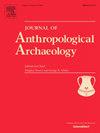Complicated endings: Household-based foodways and the demise of Early Bronze Age urban society in the southern Levant
IF 2.2
1区 社会学
Q1 ANTHROPOLOGY
引用次数: 0
Abstract
The end of the Early Bronze Age III (EB III, c. 2900–2500 BCE) period in the southern Levant (modern day Jordan, Israel, Palestine, southern Lebanon, and southern Syria) has traditionally been characterized as a time of wide-scale, total collapse. Recently, researchers have highlighted evidence for cultural continuity and slow transitions as people abandoned EB III urban settlements throughout the region to disperse into villages, hamlets, and farmsteads during the EB IV (c. 2500–2000 BCE). Focusing on the last occupations of EB III Numayra and Tall al-Handaquq South in Jordan, we examine household-based food practices as indicators of what everyday life was like for EB people living through the decline of their communities. Analyzing ceramic storage and serving vessel data, we found an overall continuity in serving and storage practices at both sites before their abandonment, suggesting that residents of both communities did not alter their daily food practices and likely maintained their social and economic networks despite approaching a ‘collapse’ of EB urbanism. However, significant decreases in platterbowl size and serving vessel decoration indicate smaller scales of food-sharing and possibly early hints of out-migration from Numayra and Tall al-Handaquq South. This research requires scholars to pursue a more nuanced understanding of EB urban abandonment, one that recognizes the continuity in foodways between terminal EB III and early EB IV settlements.

复杂的结局:以家庭为基础的食物方式和黎凡特南部早期青铜时代城市社会的消亡
在黎凡特南部(今天的约旦、以色列、巴勒斯坦、黎巴嫩南部和叙利亚南部)的早期青铜时代III (EB III,公元前2900-2500年)末期,传统上被认为是一个大规模、全面崩溃的时期。最近,研究人员强调了文化连续性和缓慢过渡的证据,因为人们在EB IV(公元前2500-2000年)期间放弃了整个地区的EB III城市定居点,分散到村庄、小村庄和农场。以约旦EB III Numayra和Tall al-Handaquq South最后的职业为重点,我们研究了以家庭为基础的食物实践,作为EB人在社区衰落期间日常生活的指标。分析陶瓷储存和服务容器数据,我们发现在这两个地点被遗弃之前,服务和储存实践的总体连续性,这表明两个社区的居民并没有改变他们的日常饮食习惯,并且可能保持他们的社会和经济网络,尽管EB城市化接近“崩溃”。然而,拼盘碗大小和器皿装饰的显著减少表明,食物分享的规模较小,可能是努迈拉和塔尔阿尔汉达克南部向外迁移的早期迹象。这项研究要求学者们对EB城市遗弃进行更细致入微的理解,认识到EB III末期和EB IV早期定居点之间食物方式的连续性。
本文章由计算机程序翻译,如有差异,请以英文原文为准。
求助全文
约1分钟内获得全文
求助全文
来源期刊

Journal of Anthropological Archaeology
Multiple-
CiteScore
4.00
自引率
11.10%
发文量
64
期刊介绍:
An innovative, international publication, the Journal of Anthropological Archaeology is devoted to the development of theory and, in a broad sense, methodology for the systematic and rigorous understanding of the organization, operation, and evolution of human societies. The discipline served by the journal is characterized by its goals and approach, not by geographical or temporal bounds. The data utilized or treated range from the earliest archaeological evidence for the emergence of human culture to historically documented societies and the contemporary observations of the ethnographer, ethnoarchaeologist, sociologist, or geographer. These subjects appear in the journal as examples of cultural organization, operation, and evolution, not as specific historical phenomena.
 求助内容:
求助内容: 应助结果提醒方式:
应助结果提醒方式:


